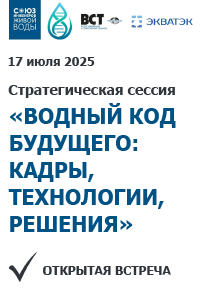№9-2|2011
POTABLE WATER SUPPLY
bbk 000000
UDC 628.16.065
Economic Efficiency of the Use of Coagulant at the Pumping-Filter Station of the City of Samara
Summary
Results of the research in using the coagulant of aluminium polyoxychloride at the pumping-filter station № 1 of the city of Samara are presented. The technical and economic performance of the pumping-filter station № 1 are enhanced, working conditions are improved, amortization, energetic and other costs are reduced due to of simplification of chemical dosing workshop, release of equipment and mechanisms. In 2010 the general costs for chemicals were cut down by 16%. The combined scheme of water treatment with the use of aluminum sulfate and aluminum polyoxychloride enhances the stability of the treatment process of low-turbid water of the Saratov Reservoir.
Key words
coagulant , flocculant , pumping-filtration station , economic efficiency
SPISOK LITERATURY
- Draginskii V. L., Alekseeva L. P., Getmantsev S. V. Koaguliatsiia v tekhnologii ochistki prirodnykh vod. – M., 2005.
- Linevich S. N., Getmantsev S. V. Koaguliatsionnyi metod vodoobrabotki. Teoreticheskie osnovy i prakticheskoe ispol'zovanie. – M.: Nauka, 2007.
- Romaniko A. N., Egorova Iu. A., Erchev V. N. i dr. Sovershenstvovanie reagentnogo metoda obrabotki vody koaguliantami na MP g. Samary «Samaravodokanal» // Vodosnabzhenie i san. tekhnika. 2009. № 9.
- Egorova Iu. A., Erchev V. N., Getmantsev S. V., Ovchinnikov V. P. Ekonomicheskoe obosnovanie primeneniia sovremennykh koaguliantov pri ochistke poverkhnostnykh vod / Tekhnologii ochistki vody «TEKhNOVOD–2009»: Materialy V Mezhdunar. nauchno-prakt. konf. «Tekhnologiia ochistki vody», posviashchennoi 120-letiiu OAO «AURAT». – Kislovodsk, Iuzhno-Rossiiskii gosudarstvennyi tekhnicheskii universitet, 2009.






